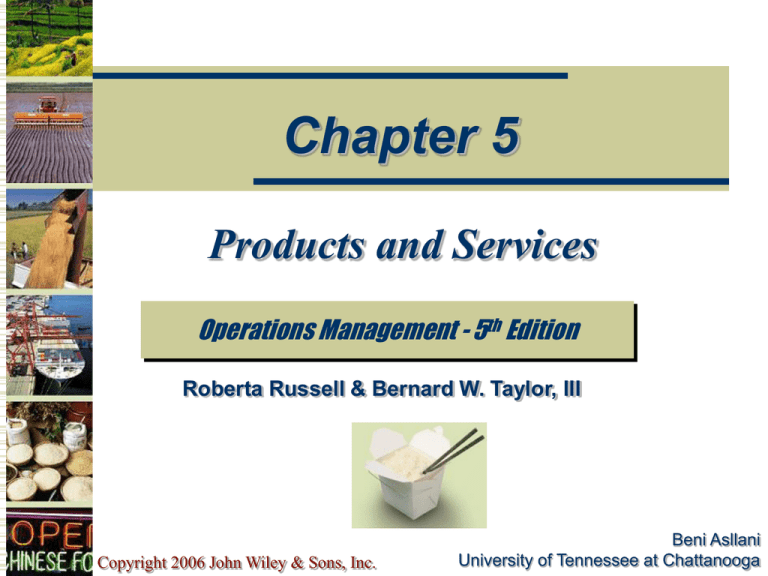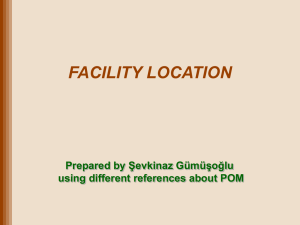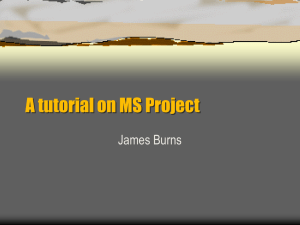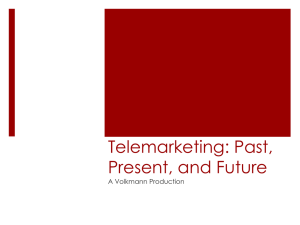
Chapter 5
Products and Services
Operations Management - 5th Edition
Roberta Russell & Bernard W. Taylor, III
Copyright 2006 John Wiley & Sons, Inc.
Beni Asllani
University of Tennessee at Chattanooga
Lecture Outline
Design Process
Reducing Time-to-Market
Improving Quality of Design
Special Considerations in
Service Design
Copyright 2006 John Wiley & Sons, Inc.
5-2
Design Process
Effective design can provide a competitive
edge
matches product or service characteristics with
customer requirements
ensures that customer requirements are met in the
simplest and least costly manner
reduces time required to design a new product or
service
minimizes revisions necessary to make a design
workable
Copyright 2006 John Wiley & Sons, Inc.
5-3
Design Process (cont.)
Product design
defines appearance of
product
sets standards for
performance
specifies which materials
are to be used
determines dimensions
and tolerances
Copyright 2006 John Wiley & Sons, Inc.
Service design
specifies what physical
items, sensual benefits,
and psychological
benefits customer is to
receive from service
defines environment in
which service will take
place
5-4
Feasibility Study
Market analysis
Economic analysis
Technical analysis (operations)
Strategic analysis
Performance specifications
Copyright 2006 John Wiley & Sons, Inc.
5-5
Operations Issues in Product Design
Product design and technology
Process technology
Would we need a new or modified facility?
How much capacity would we need?
Can the firm make this product with
consistent quality at a price that customers
are willing to pay?
Does our labor force have the needed
skills?
Form and Functional Design
Form Design
how product will
look?
Functional Design
Copyright 2006 John Wiley & Sons, Inc.
reliability
maintainability
usability
5-7
Usability
Ease of use of a product or service
ease of learning
ease of use
ease of remembering how to use
frequency and severity of errors
user satisfaction with experience
Copyright 2006 John Wiley & Sons, Inc.
5-8
Production Design
Simplification
reducing number of parts, assemblies, or options in
a product
Standardization
using commonly available and interchangeable
parts
Modularity
combining standardized building blocks, or
modules, to create unique finished products
Copyright 2006 John Wiley & Sons, Inc.
5-9
Design Simplification
(a) Original design
Assembly using
common fasteners
(b) Revised design
(c) Final design
One-piece base &
elimination of
fasteners
Design for
push-and-snap
assembly
Reducing Time-to-Market
Establish multifunctional design teams
Make design decisions concurrently rather
than sequentially
Collaborative design with suppliers and
among suppliers
Design for manufacturing
Rapid prototyping
Use computer-aided design & engineering
Copyright 2006 John Wiley & Sons, Inc.
5-11
Design Team
Concurrent Design
Simultaneous design of products and
processes by design teams
Involves suppliers in design
Uses Web-based collaborative work systems
Many tasks are done at the same time: requires
good project management
Uses a price-minus approach rather than a costplus approach to design
Copyright 2006 John Wiley & Sons, Inc.
5-13
Concurrent Design (2)
Advantages of concurrent design
Shorter time to market
Better product quality
Lower design costs
Lower production costs
Fewer product and process changes after
product is introduced
Copyright 2006 John Wiley & Sons, Inc.
5-14
General Performance
Specifications
Instructions to supplier:
“Design a set of brakes that can stop a 2200 pound car from
60 miles per hour in 200 feet ten times in succession without
fading. The brakes should fit into a space 6” x 8” x 10” at the
end of each axle and be delivered to the assembly plant for
$40 a set.”
Supplier submits design specifications and prepares a
prototype for testing
Initial prototypes are often computerized.
Copyright 2006 John Wiley & Sons, Inc.
5-15
Production Design
Simplification
reducing number of parts, assemblies, or options in
a product
Standardization
using commonly available and interchangeable
parts
Modularity
combining standardized building blocks, or
modules, to create unique finished products
Copyright 2006 John Wiley & Sons, Inc.
5-16
Design Simplification
(a) Original design
Assembly using
common fasteners
(b) Revised design
(c) Final design
One-piece base &
elimination of
fasteners
Design for
push-and-snap
assembly
Design for Manufacturing
Design a product for easy and
economical production
Incorporate production design early in
the design phase
Benefits
Improves quality and reduces costs
Shortens time to design and manufacture
Copyright 2006 John Wiley & Sons, Inc.
5-18
Design for Manufacturing
Guidelines
Minimize the number of parts, tools, fasteners, and
assemblies
Use standard parts and repeatable processes
(processes that always work)
Modular design
Design for ease of assembly, minimal handling
Allow for efficient testing and parts replacement
Copyright 2006 John Wiley & Sons, Inc.
5-19
Value analysis (VA)
Can we do without it?
Does it do more than is required?
Does it cost more than it is worth?
Can something else do a better job?
Can it be made by
a less costly method?
with less costly tooling?
with less costly material?
Can it be made cheaper, better, or faster by
someone else?
Copyright 2006 John Wiley & Sons, Inc.
5-20
Rapid Prototyping
Build a prototype
form design
functional design
production design
Test prototype
Revise design
Retest
Copyright 2006 John Wiley & Sons, Inc.
5-21
Design for Environment
Design for environment
designing a product from material that can be recycled
design from recycled material
design for ease of repair
minimize packaging
minimize material and energy used during manufacture,
consumption and disposal
Extended producer responsibility
holds companies responsible for their product even after its
useful life
Copyright 2006 John Wiley & Sons, Inc.
5-22
Design for Environment (cont.)
Copyright 2006 John Wiley & Sons, Inc.
5-23
Technology in the
Design Process
Computer Aided Design (CAD)
assists in creation, modification, and
analysis of a design
includes
computer-aided engineering (CAE)
tests and analyzes designs on computer screen
computer-aided manufacturing (CAM)
ultimate design-to-manufacture connection
Copyright 2006 John Wiley & Sons, Inc.
5-24
Computer-Aided Design &
Engineering
Computer-aided design (CAD): use of computer
software to design products
Computer-aided engineering (CAE): use of computer
software to evaluate and improve product designs
Specialized CAD/CAE software is used by architects
and landscape architects
Copyright 2006 John Wiley & Sons, Inc.
5-25
Advantages of CAD and CAE
Marketing: Firms can design better products and get
them to market faster
Finance: CAD and CAE reduce design costs,
production costs, and the number of major product
and process changes needed
Operations: It is easier to make the product and to
maintain good quality.
General: Easier to use concurrent engineering, value
engineering, design for manufacturing, and to involve
suppliers in product design.
Copyright 2006 John Wiley & Sons, Inc.
5-26
Data Flow in Manufacturing Technology
Computer
aided
design
(CAD)
Computer
aided
process
planning
(CAPP)
Product
design
data
No
Computer
aided
engineering
(CAE)
Manufacturing
instructions
Computer
aided
manufacturing
(CAM)
Final
design?
Final
Yes
design
data
Finished
goods
Design for Robustness
Product can fail due to poor design quality
Products subjected to many conditions
Robust design studies
Controllable factors - under designer’s control
Uncontrollable factors - from user or environment
Designs products for consistent performance
Copyright 2006 John Wiley & Sons, Inc.
5-28
Design for Robustness (2)
Customers prefer product characteristics
near their ideal values
Systemic (common cause) errors result from
problems in the product design, materials, or
process
Systemic errors affect more customers than random
errors.
Systemic errors can be detected and should be
corrected.
Copyright 2006 John Wiley & Sons, Inc.
5-29
Copyright 2006 John Wiley & Sons, Inc.
All rights reserved. Reproduction or translation of this work beyond that
permitted in section 117 of the 1976 United States Copyright Act without
express permission of the copyright owner is unlawful. Request for further
information should be addressed to the Permission Department, John Wiley &
Sons, Inc. The purchaser may make back-up copies for his/her own use only and
not for distribution or resale. The Publisher assumes no responsibility for
errors, omissions, or damages caused by the use of these programs or from the
use of the information herein.









